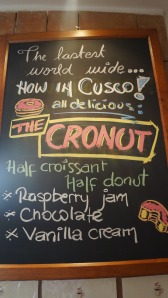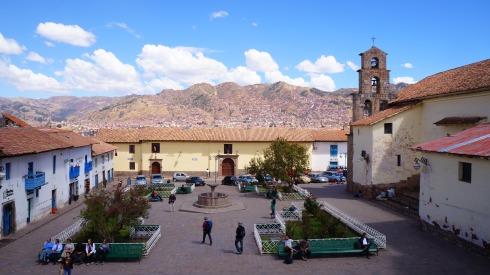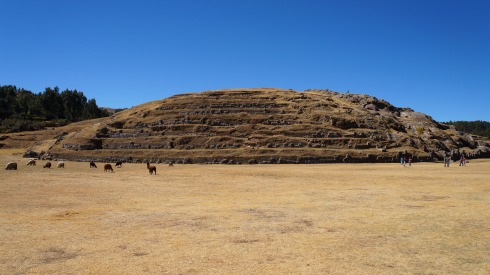If a current day Inca King had the choice of where to build his palace and base his army, there’s no doubt that Cusco would be it. This city in the clouds attracts hundreds of thousands of international visitors every year who are drawn here by colonial majesty built amidst the cobbled alleyways and mighty stone walls of the Incas. Often described as the ‘archaeological capital of the Americas’, Cusco is bursting with historic sites and is the gateway to the beautiful Sacred Valley where Inca fortresses are perched on hill tops and indigenous locals farm and sell their goods at colourful markets as they have done for hundreds of years. Peru’s poster boy is the world-famous Machu Picchu, lost city of the Incas, and Cusco is also the starting point for an unforgettable trip to this new wonder of the modern world.
We found a great guest house in San Cristobal, an area of the old town, and because we were planning to spend a few days in Cusco, do the Salkantay trek to Machu Picchu, and then return for another few days, we were able to negotiate a discounted rate per night.
When we started our journey in Latin America, our polite, some would say conservative, British demeanor, would have never caused us to barter for a room but an encounter with two savvy girls from Israel back in Chile and several budget smart travellers since, has taught us that prices aren’t always set in stone in Latin America – everything is a negotiation – even your hotel room.
With our bags stored in our room and a quick change of clothes, we headed out to ‘Norton’s Rat’, a bar which featured long wooden tables and high stools on a sun-filled balcony overlooking the main square. We always find that a good way to get to know a new country is through its beer so we lined up a couple of large bottles of Cusquena and took in the views.
The plaza is awash with colonial splendor. The eighteenth century cathedral dominates the skyline and stands on the site of Inca Viraconcha’s palace. After defeating the Incas in the late seventeenth century, the Spanish ransacked the city, pulling down many of the stone wall dwellings belonging to the Incas and replacing them with mansion houses with lavish wooden balconies as was the style in Europe at the time. The sacred Inca site of Saqsaywaman, which looks over the city, was desecrated and the giant stone walls used to create the new buildings, including the cathedral. The Spanish mansions around the square have now been converted to please the tourist hordes and now house restaurants, cafes, souvenir shops, and tourist agencies.
People watching in the plaza was addictive. Below us the descendents of the Incas and Spaniards went about their daily business and mixed with the tourists. Women and children in brightly coloured, multi-layered outfits strolled around with baby goats and llamas accosting tourists for photographs and charging for the privilege. Shoe-shiners polished business men’s shoes until they could see their faces in them and an ice-cream vendor rang a bell as he pushed a small cart in large circles.
Despite the number of tourists, we found Cusco a very relaxing and enjoyable place to spend a few days. Cusco is a big city and home to around 360,000 people, however, all of the main sights, viewpoints, restaurants and bars are clustered in the old town within easy walking distance of each other. The city is built on hills and there are several excellent places to get a birdseye view over the city. We enjoyed the panorama from the church of San Cristobal.
After a short but steep climb through the back streets off the main plaza it’s possible to peer down on the old town walls and church spires. The majority of buildings are painted white and many still have their original terracotta roofs. Where the old town ends, the new town takes over – the concrete jungle of brick walled and tin roofed buildings sprawl in every direction with no thought for city planning. We could see snowy peaks in the distance which reminded us that the city stands at an altitude of 3,400 metres above sea level and they were a striking contrast to the rolling hills of golden grass encircling the city.
Feeling hungry one lunchtime, we decided to check out the large central market selling all sorts of local produce. The market can be found just past Plaza San Fransisco which is another beautiful space in the centre of Cusco where we often saw large crowds who’d gathered to watch theatre or musical performances outside the church.
The market was huge and set inside what looked like a large aircraft hangar. Due to its size, the stalls were grouped into sections so people could easily find what they were looking for. Fish, meat, dairy produce, fruit and vegetables and small kitchens, usually specialising in one or two dishes, all had their own place. The market stall owners were incredibly proud of their patches which were immaculately clean and tidy. Colourful bunting which was strung from the ceiling brought even more colour inside.
The only section where it was necessary to have a strong stomach was the meat section as it seems the Peruvians will waste nothing with trotters, intestines, tongue and heart were all available for purchase. We headed to one of the small kitchens and tried to work out which ones were most popular with the locals and then if we could fathom what exactly it was they were selling.
Feeling experimental, we ordered a dish Peru is famous for called Ceviche and took a seat with hopeful anticipation. Ceviche is a dish of raw fish marinated in fresh lime juice and combined with onions, peppers, cucumber, chopped tomato and herbs. Similar to sushi, the marinating process partly cooks and firms the fish, infusing it with heaps of flavour. Tentative prodding of the food which arrived before us turned into huge forkfuls being devoured and in no time our plates were empty. Our gamble paid off – we really enjoyed the food and we left feeling happy to have a new dish in our repertoire.
For more conventional and international dishes we found the winding cobbled alleyways of San Blas to be an excellent choice – not to mention the views! We could be transported back to England with the fried breakfasts in Jacks Cafe, to France with the sweet and savory crepes at La Boheme and to New York with stuffed sandwiches and dips at Juanito’s. We even found a bakery serving up a taste sensation which is sweeping the globe – the Cronut. We’d heard from New Yorker and rafting friend Jo about this hybrid and we were keen to try it for ourselves but we’d never assumed that a small deli in Peru’s historical capital would be the spot to tantilise our taste buds. Half croissant and half donut, these mouth-watering morsels came in a variety of flavours so we took chocolate and raspberry and salivated for the next 5 minutes as we slowly devoured every last crumb.
San Blas has an arty, bohemian feel and it’s easy to lose a few hours window shopping, stopping for coffee and admiring the views of the old town.
The small, interwoven lanes lead upwards and eventually spill out onto pretty San Blas plaza with its white washed church and ornate fountain.
For a slice of Inca history without leaving the city walls there are several good options. Walking through the atmospheric alleyway Loreta from Plaza de Armas it’s possible to see the oldest Inca walls in Cusco on the left which form part of the House of the Chosen Woman. The walls were giant and in places up to a metre thick.
The Incas were master craftsmen – in an era where there were no machines to measure and cut the stones everything would have been painstakingly done by hand – and not to mention the building process! The polished dry stone walls were designed to fit together without mortar so it’s not unusual to find stones adjoining eight or ten others.
An uphill climb to the northern outskirts of Cusco leads to the ruins of the walled fortress of Saksaywaman which was added to the Unesco World Heritage list in 1983. We were disappointed to find that to enter the site it was necessary to purchase an expensive tourist ticket (130 Peruvian Soles or 43 USD). It was valid for 5 days and gave entrance to a number of historical attractions in and around Cusco but we really only wanted to visit this site. Not deterred by the vicious looking lady on the gate, we searched for an alternative. We quickly knew what we’d have to do…and a few minutes later we found ourselves scrabbling on hands and knees up a steep, muddy incline. Flinging ourselves over a barbed wire fence and hauling ourselves over some of the very ruins we’d come to see, we emerged from the bushes looking rather guilty and hoping that security wouldn’t spot us. We were in luck – we had made it – and shamefully, it felt really good to beat the system and not to pay the extortionate entrance fee.
Apparently the destructive Spaniards left a mere 20% of the original site still standing, and that was only because some of the stones were too large to be easily moved. There is however, a huge amount to see so the original Inca site must have been huge and truly spectacular.
The best known zone in Saqsaywaman is the Great Plaza and the three adjacent terrace walls. The biggest of these walls is around 400 metres in length and 6 metres tall, with the largest blocks weighing up to 200 tonnes.
Saqsaywaman translates as ‘Satisfied Falcon’ although the travelling community usually remembers it by its nickname ‘Sexy Woman’! The Incas thought Cusco was the shape of a puma with Saqsaywaman positioned at its head. The 22 zig-zag walls on top of the three-tiered fortification were said to form the teeth of the puma.
The fortress was built on one of the highest points around the city for defensive purposes and lucky for us this meant that the views over Cusco were wonderful.
In 1536 the fortress was one of the last places in Cusco held by the Incas and a ferocious and bloody battle ensued to defend the site from the Spanish conquistadors. The Incas were defeated and for days afterwards Andean condors circled the site picking flesh from the thousands of dead bodies that littered the site. In memory of this tragedy, the Cusco coat of arms now includes eight condors.
We ended our time in Cusco in the same way we had begun – in the pub! Paddy’s bar is proud to boast about its credentials as the highest Irish pub in the world. The bar was fitted out with dark wooden furniture, served home comforts such as steak and ale pie and welcomed groups of travellers who were sat on high stools clustered around circular tables. In the morning, Dan and I would embark on an epic journey…a 5 day pilgrimage to the most important historical site the Incas gave the world – Machu Picchu. We drank a beer and wondered what the Incas would have thought about their city if they could have been offered a glimpse into the future. We came to the conclusion that they would have liked it immensely and felt incredibly proud of the legacy they left behind.

























Oh my gawd! Cronuts! Ding Dong!! You guys broke into a fortress named sexy woman??! You two are really my heroes! We are thinking of you today-we just checked into Hotel Nuevo Soles in La Paz today!! They gave us the right price this time with no haggling. Hope you are both well. Great to read your adventures 🙂